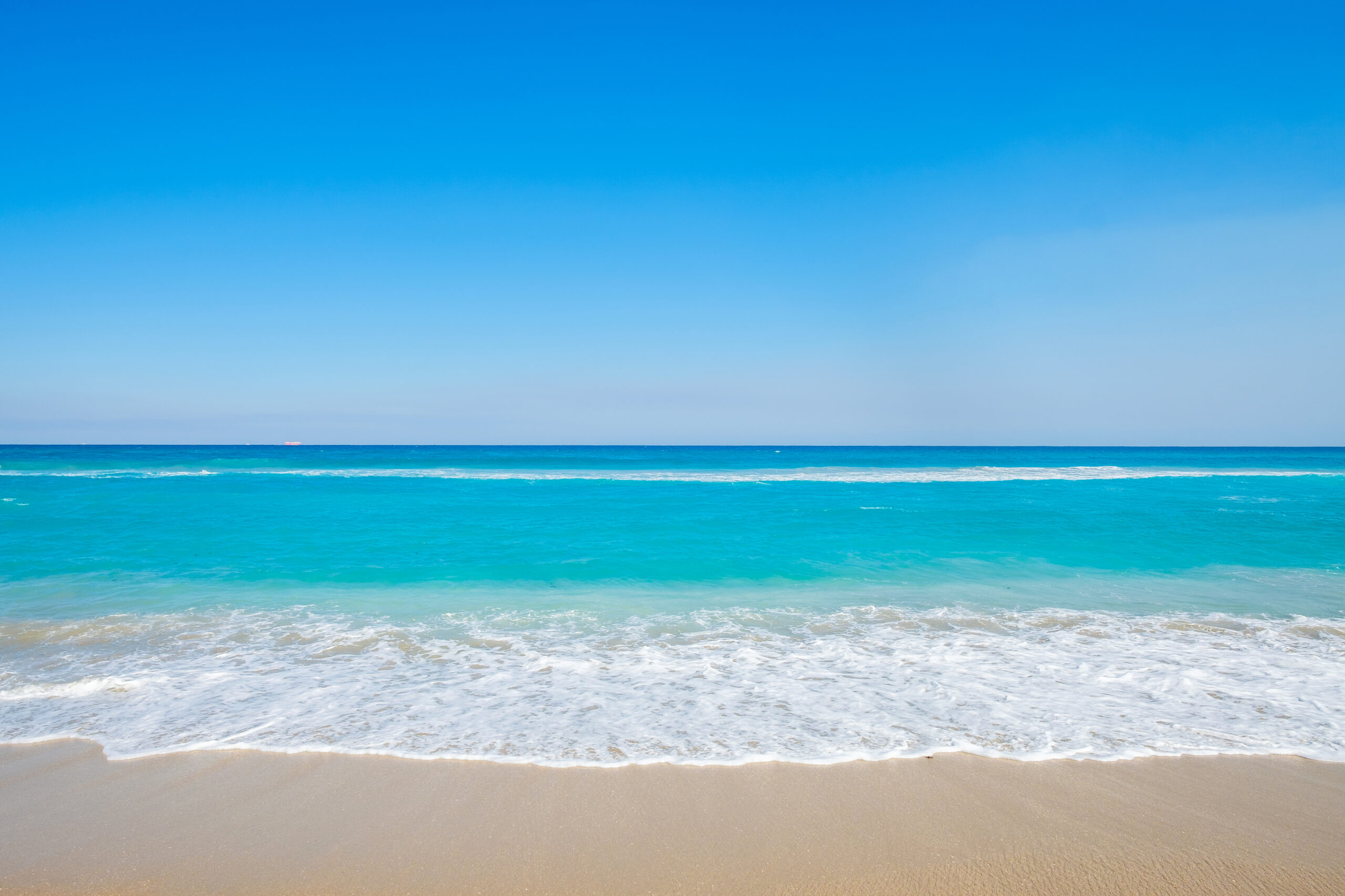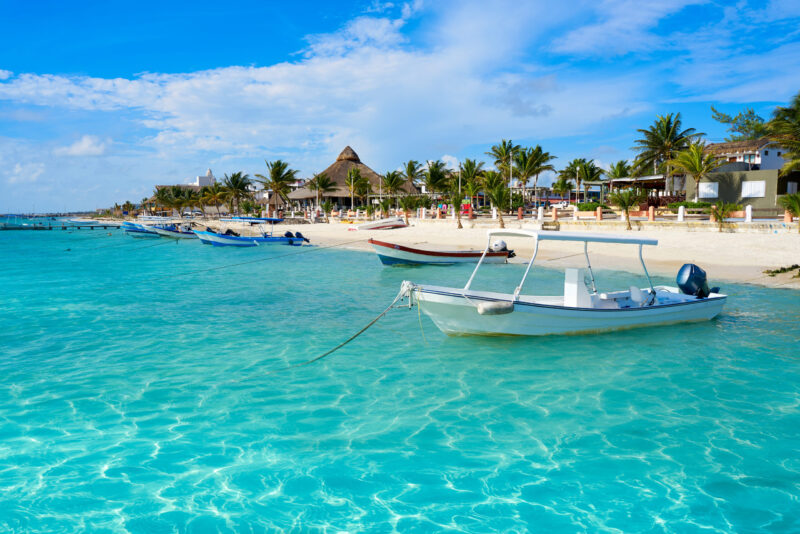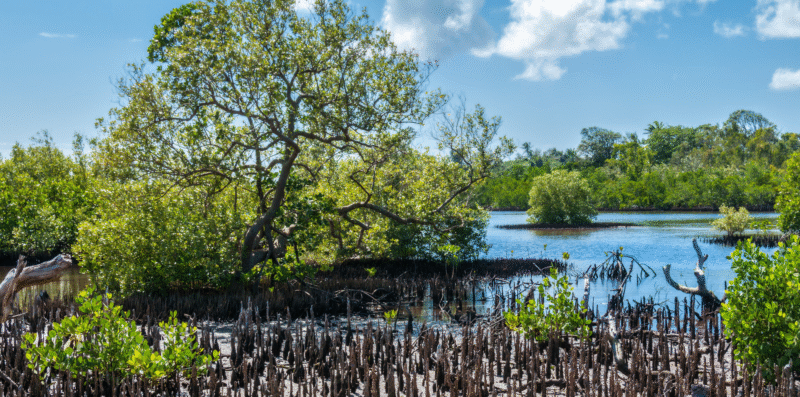In a first-of-its-kind study by Beach.com, analyzing over 1,300 beaches in Florida, Georgia, South Carolina, and North Carolina, Florida dominates the rankings for best beaches in the U.S. Southeast.
Using NASA satellite data, natural language processing, and proximity data, we identify the best beaches in the U.S. Southeast, supported by hundreds of thousands of data points.
A clear narrative emerges: Florida’s Atlantic coast, particularly Palm Beach County, is home to the bluest, clearest water and highest-rated experiences in the Southeast. Most of these beaches are on Florida’s East Coast. However, if you’re looking for beaches on Florida’s Gulf Coast, you should check out our guide to Florida’s Best Gulf Coast Beaches.
Table of Contents
- Key Findings
- The 12 Best Beaches in the Southeast
- Ocean Reef Park, Riviera Beach, Florida
- Riviera Beach, Riviera Beach, Florida
- John D. MacArthur Beach State Park, North Palm Beach, Florida
- Carlin Park, Jupiter, Florida
- Pompano Beach Fisher Family Pier, Pompano Beach, Florida
- Pensacola Beach, Pensacola Beach, Florida
- Washington Oaks Gardens State Park, Palm Coast, Florida
- Jaycee Park, Vero Beach, Florida
- Grayton Beach State Park, Santa Rosa Beach, Florida
- Lauderdale-by-the-Sea Beach, Fort Lauderdale, Florida
- Coral Cove Park, Tequesta, Florida
- Juno Beach Park, Juno Beach, Florida
- Behind the Rankings: Cleanest, Clearest, and Most Loved Beaches in the Southeast
- Your Dream Beach Is Out There; We’ll Help You Find It
- Sources and Methodology
- Fair Use
Key Findings
- The best beaches in the U.S. Southeast are Ocean Reef Park, Riviera Beach, John D. MacArthur Beach State Park, and Carlin Park, all located in Palm Beach County, FL.
- Delray Public Beach in Palm Beach County, FL, has the bluest and clearest water in the analysis.
- Washington Oaks Gardens State Park in Palm Coast, FL, ranks highest in the overall experience category.
- Bonnett Street Public Beach Access in Nags Head, NC, ranks highest in accessibility and strong reviewer sentiment.
- The Great Dunes Pavilion in Jekyll Island, GA, ranks highest for facility quality.
The 12 Best Beaches in the Southeast
What makes a beach “best” is not just difficult to measure but also highly subjective. To answer this question with the broadest scope and highest quality possible, we identified aspects that are most likely to contribute to a superior beach experience, for anyone. The following beaches are ranked based on 10 key factors, informed by data analytics and expert insights. Regardless of your ideal beach vibe, the following factors are likely important to you when planning the perfect beach vacation.
The following top-ranking beaches all score high in the following:
- Blue Water Color
- Crystal Clear Water Clarity
- Ease of Beach Access
- Pristine Environment
- Clean and Safe Facilities
- Strong Positive Emotions from Beachgoers
- A Well-Rounded Experience
- Proximity to Transportation
- Well-reviewed on Google
- Highly reviewed on Google
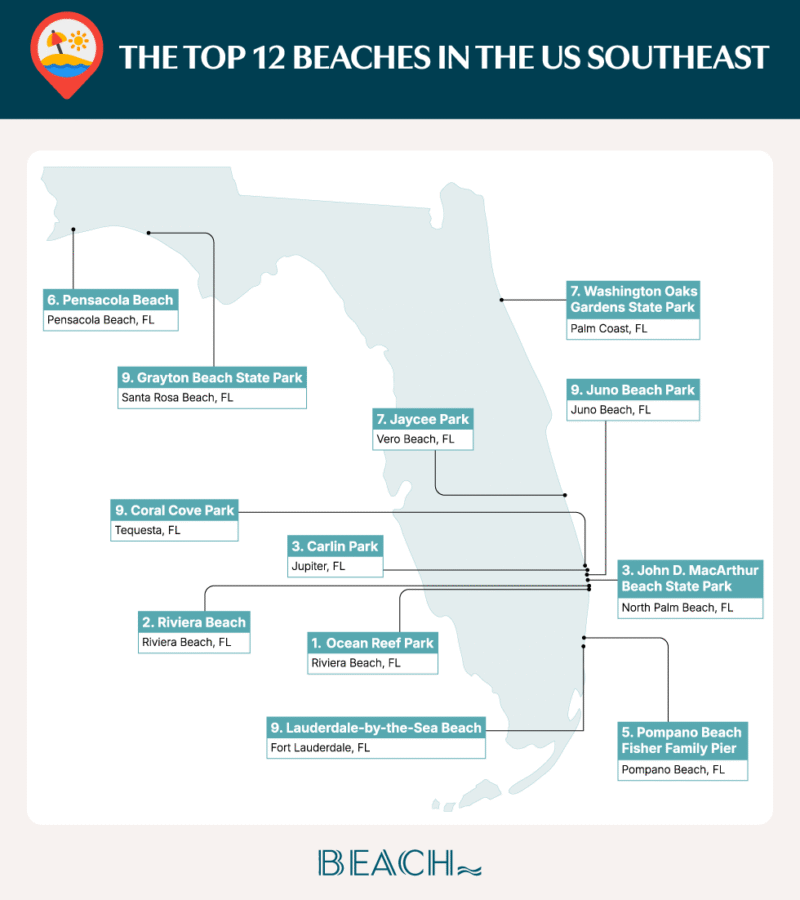
1. Ocean Reef Park, Riviera Beach, Florida
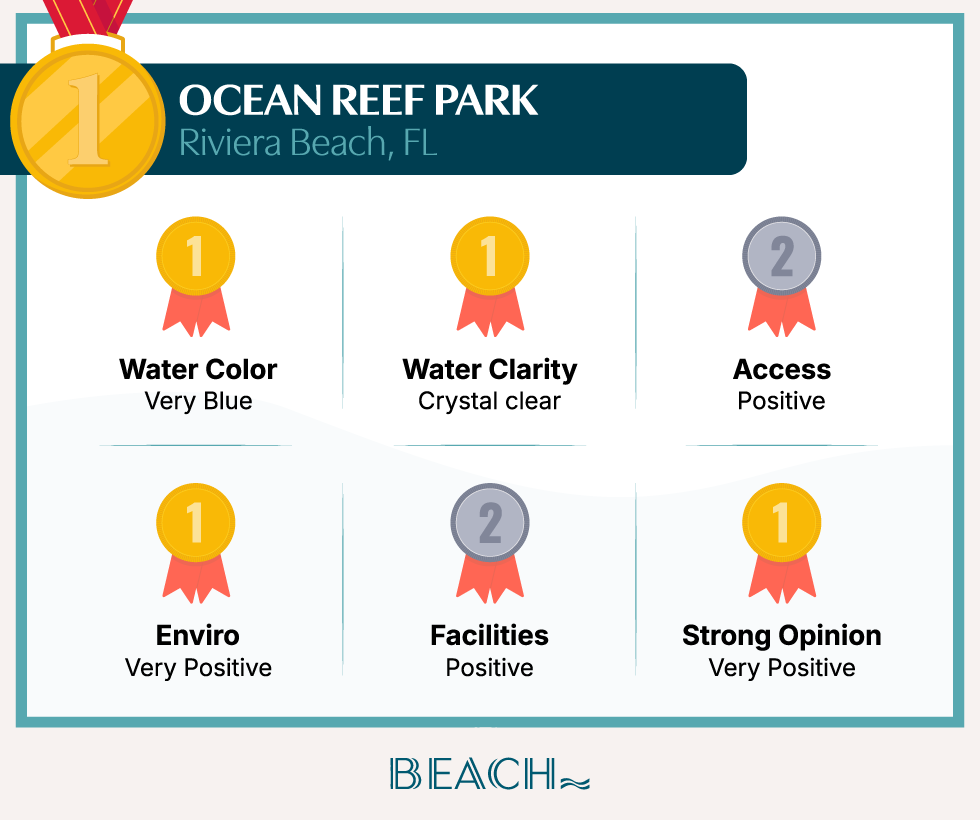
The data paints a perfect picture of the absolute #1 best beach in the southeast U.S. Ocean Reef Park, in Palm Beach County, Florida, boasts some of the bluest and clearest water in our entire analysis. It’s the kind of Instagrammable beach that everyone craves.
Beachgoers’ opinions also support the science; reviewers on Google Maps praise the park’s trash-free and environmentally clean environment. While access to the beach and its facilities is positively discussed, visitors rave about the overall experience, using very positive, strong language to describe their time here.
More Info: discover.pbcgov.org; 3860 N Ocean Dr, Riviera Beach, FL 33404
2. Riviera Beach, Riviera Beach, Florida
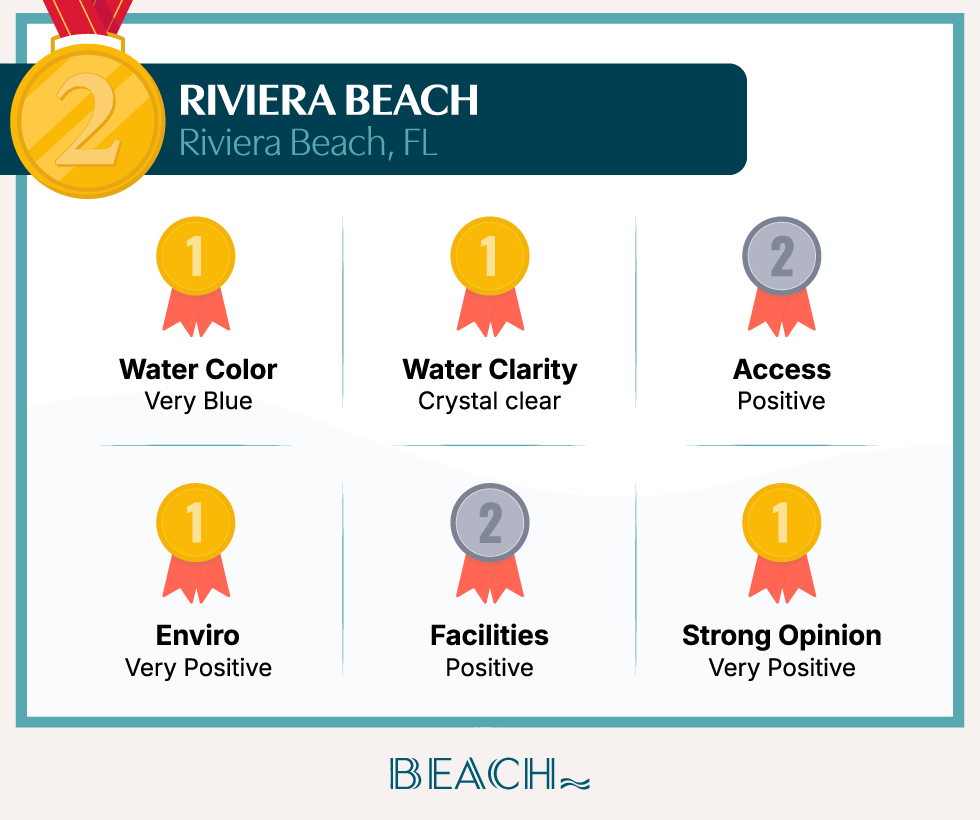
Perhaps unsurprisingly, the #2 best beach in the U.S. southeast is just a one-mile stone’s throw from our #1. With nearly identical, crystal-clear, and very blue water quality, Riviera Beach almost ties with Ocean Reef Park. As with our #1 beach, Riviera Beach boasts strong, very positive reviews for its environmental cleanliness and overall experience.
In fact, with over 4,600 reviews and a 4.7-star rating average on Google, Riviera Beach is clearly a crowd-pleaser. With that many reviews, its very positive rating for strong, emotion-laden reviews is a testament to the superb value this beach offers.
More Info: thepalmbeaches.com; 2500 N Ocean Ave, Riviera Beach, FL 33404
3. John D. MacArthur Beach State Park, North Palm Beach, Florida
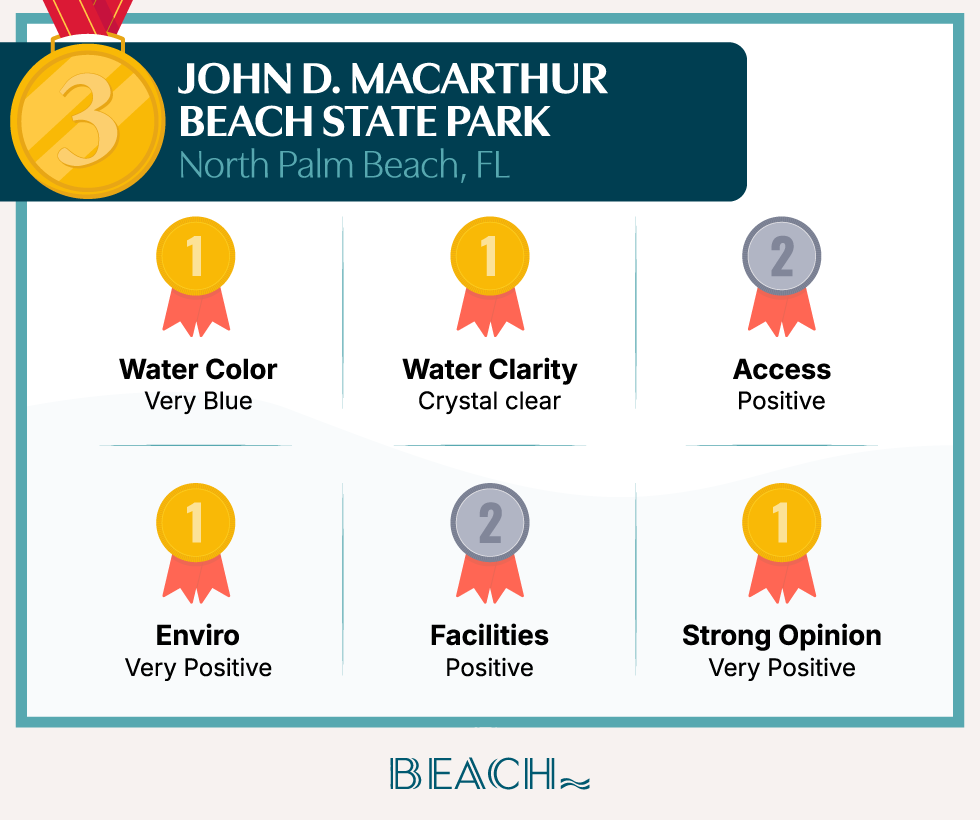
The real MVP of our analysis is Palm Beach County, where yet again, our #3 best beach in the U.S. southeast is located — John D. MacArthur Beach State Park. It’s a couple of miles north of Riviera Beach and hosts the same very blue, crystal clear water that rivals any tropical postcard.
What really sets this beach apart is that it earns the second-highest environmental score in our 1,300-beach analysis. This beach is so pristine that virtually nobody has anything negative to say about its well-kept coastline.
What also sets the John D. MacArthur Beach apart is seclusion. While our #1 and #2 beaches are idyllic, they can witness more crowds than the 438-acre MacArthur Beach State Park. If perfectly blue, crystal-clear water in an untouched environment, away from crowds, is your thing, then our #3 is your #1.
More Info: floridastateparks.org; 10900 Jack Nicklaus Dr, North Palm Beach, FL 33408
3. Carlin Park, Jupiter, Florida
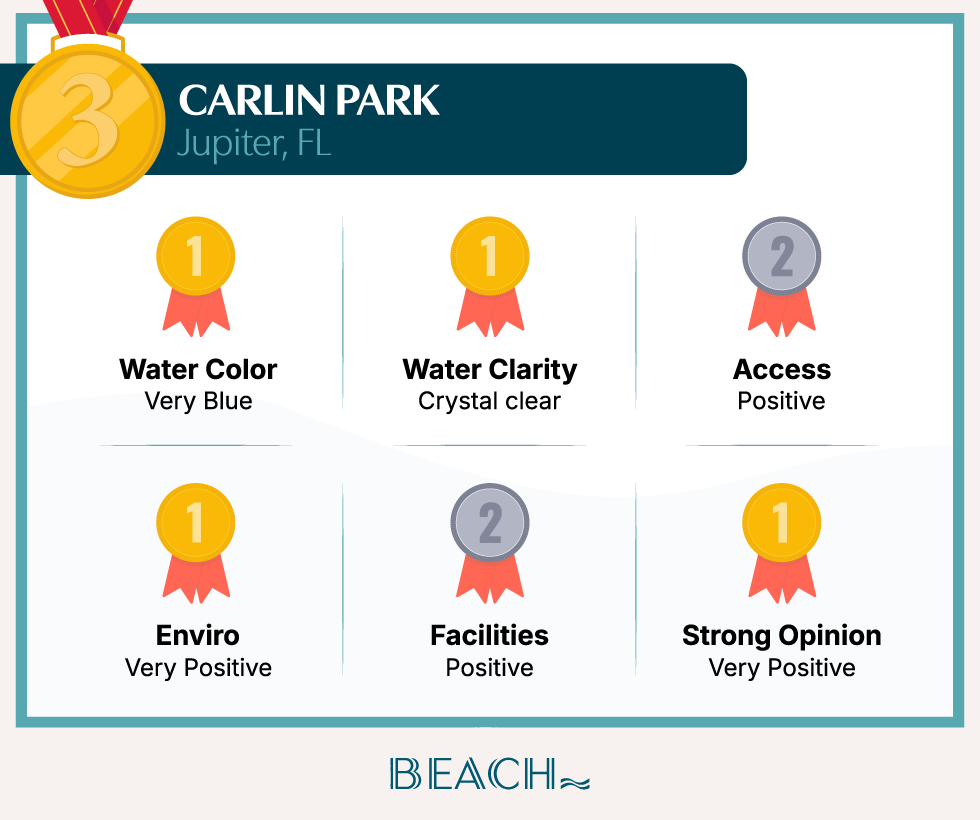
Heading north up the coast, about eight miles from John D. MacArthur, is Carlin Park in Jupiter, Florida, which, of course, is in Palm Beach County. Carlin Park earns its place with well-rounded placements in each of our ten categories. While the water color barely qualifies as very blue in our results and has very clear, but not crystal clear, water, the rest of the metrics propel it to its rank.
Carline Park has higher-rated beach facilities than all the beaches that rank above it. Visitors also frequently use very strong, positive emotions to describe their experiences at this beach. In fact, Carlin Park elicits the fifth-strongest positive emotions from beachgoer reviews. Additionally, it earns a very positive rating for environmental cleanliness and overall experience.
More Info: discover.pbcgov.org; 400 Jimmy Buffett Mem Hwy, Jupiter, FL 33477
5. Pompano Beach Fisher Family Pier, Pompano Beach, Florida
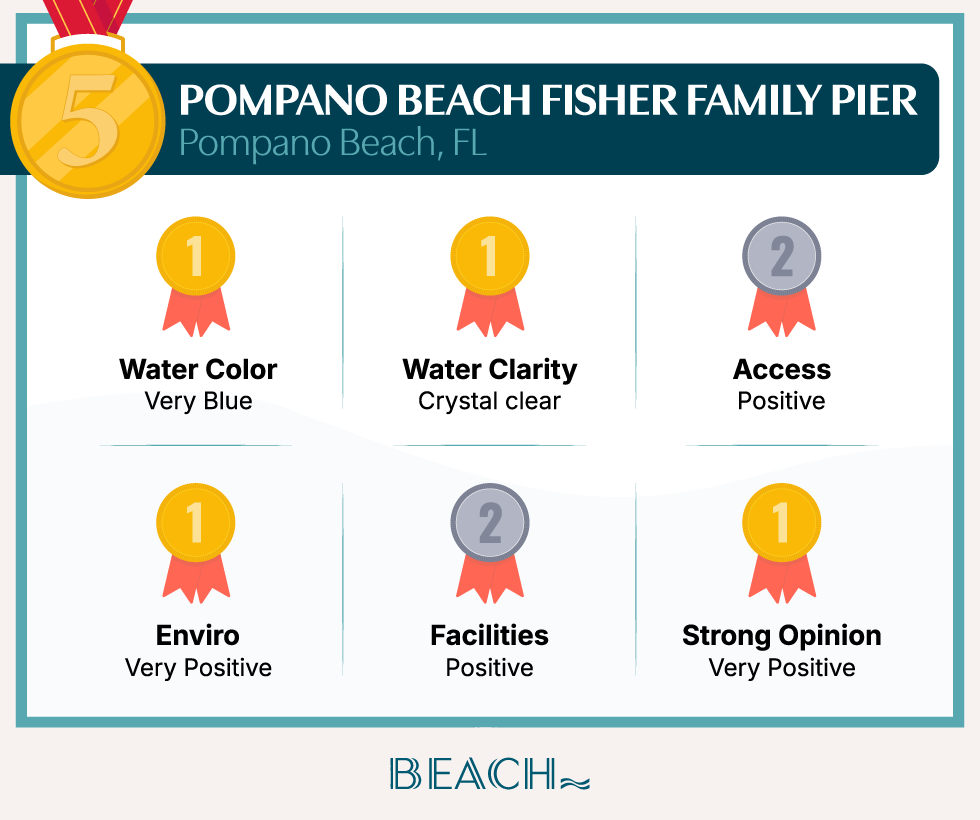
Nestled between Boca Raton and Fort Lauderdale is the Pompano Beach Fisher Family Pier in Pompano Beach, Florida. With the duo of both crystal-clear and very blue water, this beach is a visual knockout, and the data backs it up.
Pompano Beach earns very positive scores for environmental cleanliness, strong positive reviews, and an overall excellent experience. The beach only earned a positive rating for its facilities. However, it’s worth mentioning that no beach in our analysis earned a very positive rating for facilities. In fact, Pompano Beach has the fourth-best facilities rating in the entire analysis.
More Info: parks.pompanobeachfl.gov; 222 N Pompano Beach Blvd, Pompano Beach, FL 33062
6. Pensacola Beach, Pensacola Beach, Florida
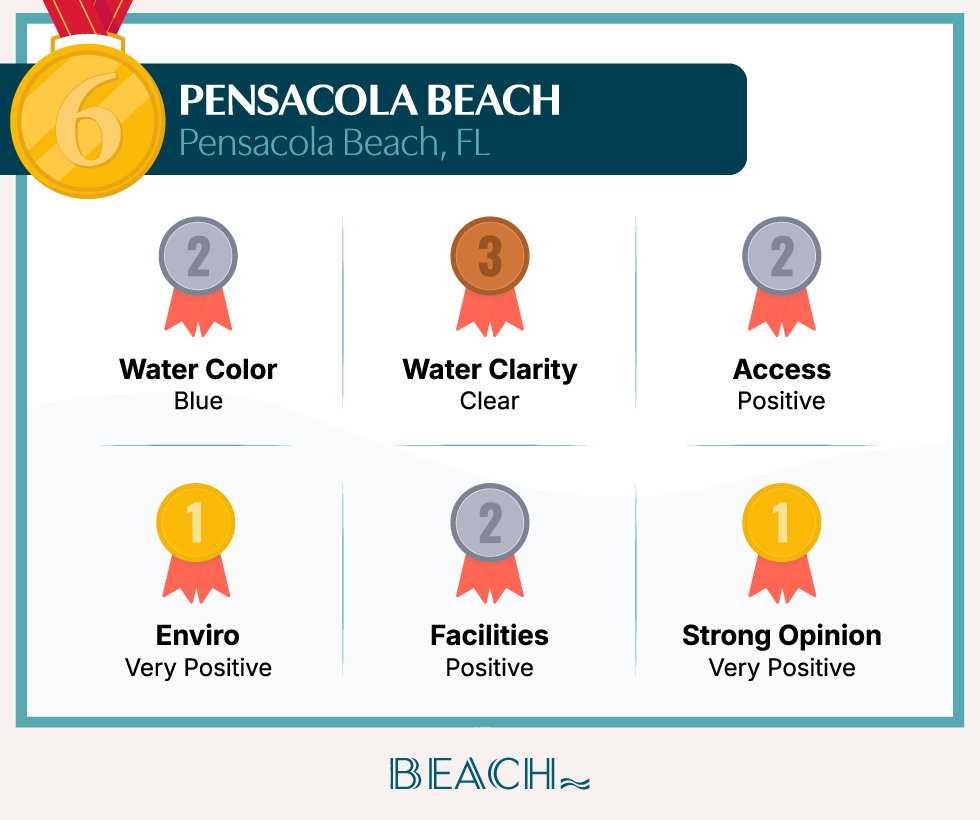
Off to the Gulf side of things, where Pensacola Beach makes its mark. The beach boasts clear and blue waters (not the very clear and very blue of its higher-ranked competitors). While the water is not quite as blue and transparent as some spots in Southeast Florida, it is a highly reviewed and beloved beach.
With over 8,000 Google reviews, it has nearly double the reviews of the second-most rated beach in the top 12. Despite the impressive volume of reviews, the beach maintains a near-perfect 4.8-star rating. Data aside, this is one of the beaches in the U.S. Southeast that I can personally attest to as a stellar experience.
visitpensacolabeach.com; 41 Fort Pickens Rd, Pensacola Beach, FL 32561
7. Washington Oaks Gardens State Park, Palm Coast, Florida
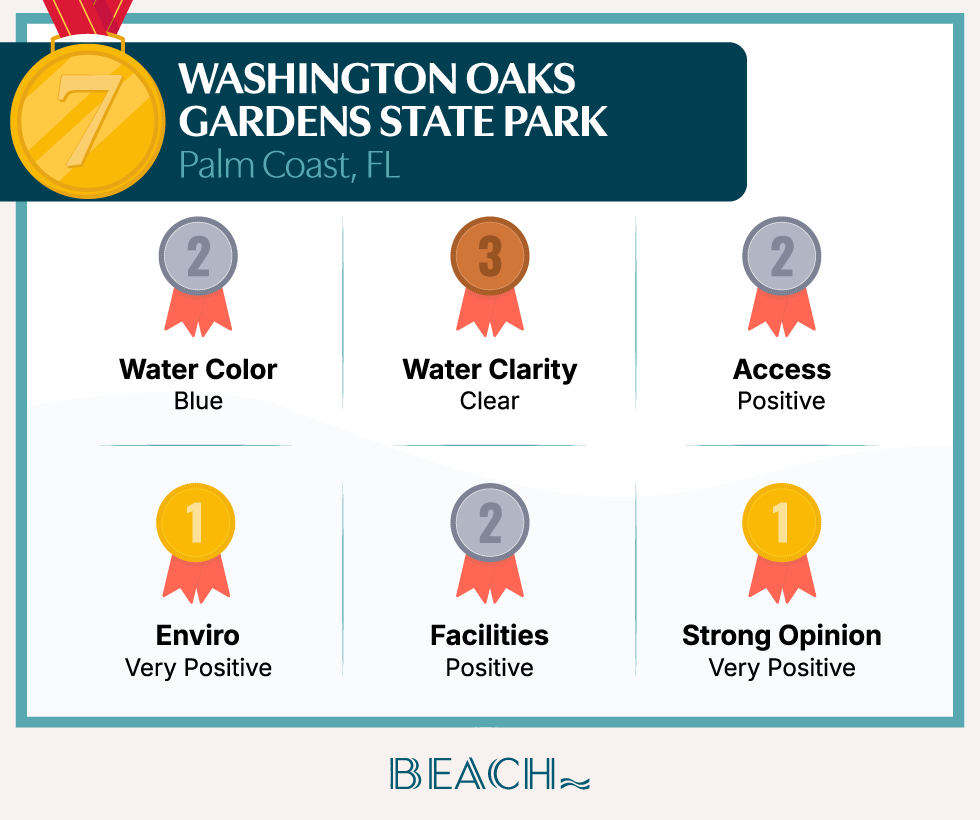
Back to the Florida east coast, but further north. Just an hour’s drive from Daytona Beach is Washington Oaks Gardens State Park in Palm Coast, Florida. Coquina rock formations, manicured rose gardens, giant towering oak trees and tide pools — this is what this beach brings to the table.
Washington Oaks also features blue (though not very blue) and clear (though not crystal clear) waters. Yet, the environment is so pristine that the beach ranks #3 overall in our environmental cleanliness category. Washington Oaks is such a well-rounded experience that it ranks #1 overall in the entire analysis in the overall experience category.
More Info: floridastateparks.org; 6400 N Ocean Shore Blvd, Palm Coast, FL 32137
7. Jaycee Park, Vero Beach, Florida
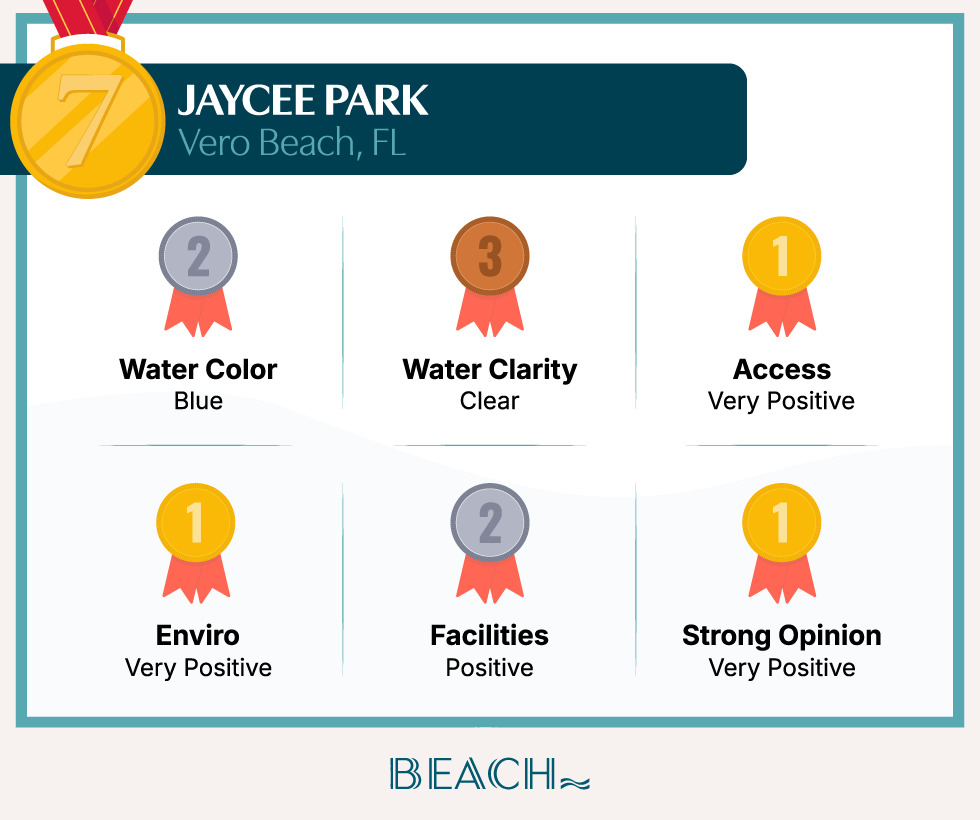
Down to Florida’s Treasure Coast, where Jaycee Park in Vero Beach, Florida, punches well above its weight. What makes Jaycee Park a standout is its excellent beach access. Only one of two beaches in the top 12 ranks earns a very positive rating for its access; you can rely on ample parking, mere steps away from the shore.
With clear, blue waters and very positive scores for environmental cleanliness, overall experience and strong, positive reviewer language, Jaycee Park may be small, but with over 2,500 reviews and a 4.7 average star rating, this beach earns the right to play with the big dogs.
More Info: covb.org; 4200 Ocean Dr, Vero Beach, FL 32963
9. Grayton Beach State Park, Santa Rosa Beach, Florida
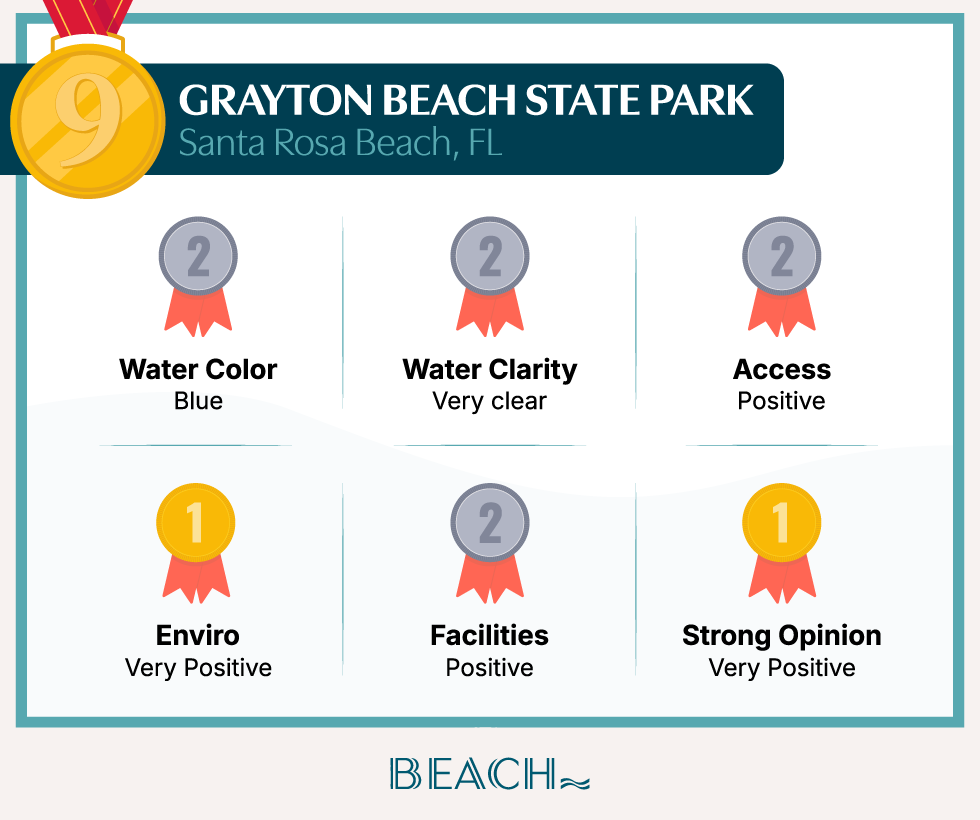
Back to the Gulf coast, nestled in between Destin and Panama City Beach, is Grayton Beach State Park. Satellite analysis reveals that this beach consistently has very clear blue waters. Reviews for environmental cleanliness rank it #8 overall in that category.
Although the beach is about an hour away from the closest airport, it offers 2,000 acres of pristine scenery. This beach can require a little more effort to reach, but if seclusion and avoiding the crowds is a top factor in what makes a beach best for you, then Grayton Beach State Park should be in your top three to visit in the southeast U.S.
More Info: floridastateparks.org; 357 Main Park Rd, Santa Rosa Beach, FL 32459
9. Lauderdale-by-the-Sea Beach, Lauderdale-by-the-Sea, Florida
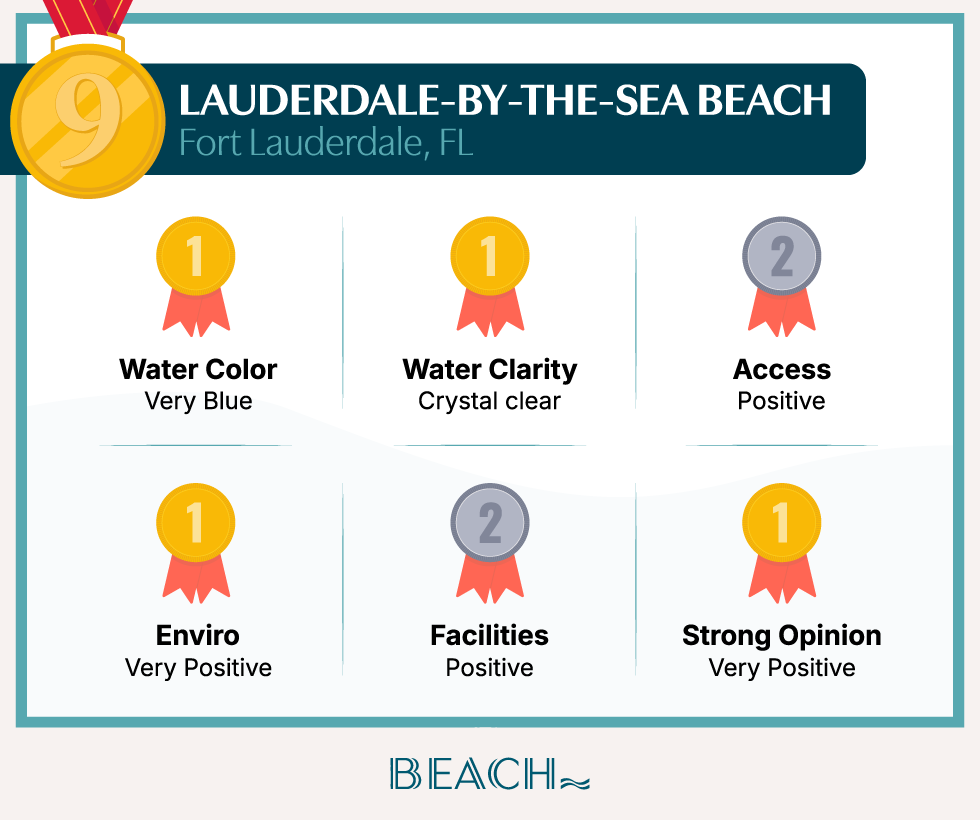
Just 15 miles north of Fort Lauderdale is the very pedestrian-friendly Lauderdale-by-the-Sea. This beach receives the highest marks in our water analysis, earning a designation of crystal-clear and very blue waters. In fact, Lauderdale-by-the-sea has the 15th clearest waters in the entire analysis.
At just around 15 miles from Fort Lauderdale-Hollywood International, you don’t have to go too far out of your way to access this local gem full of coastal town charm. While access, particularly parking, can be a bit tricky here sometimes, it’s not the hardest city beach to get to. Although it receives a fair amount of traffic, the beach facilities rank as the 12th best in the entire analysis.
More Info: discoverlbts.com; 4229 N Ocean Dr, Lauderdale-By-The-Sea, FL 33308
9. Coral Cove Park, Tequesta, Florida
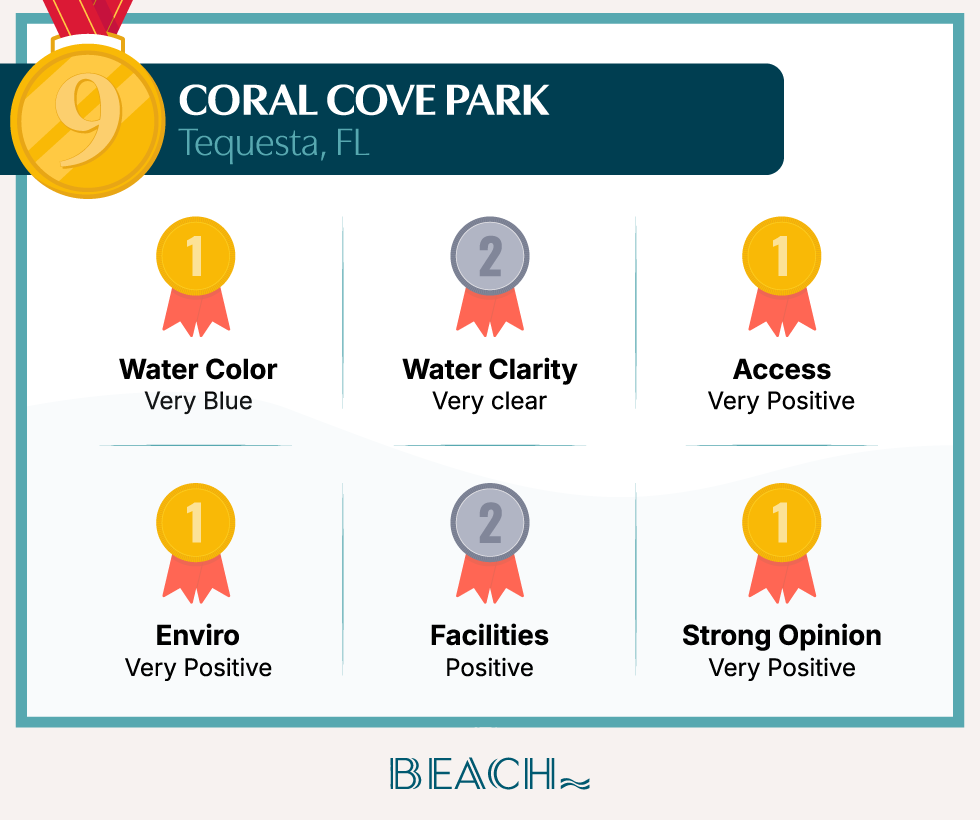
This one’s a hidden gem. Tucked away in the far northeast corner of Palm Beach County, Florida, is Coral Cove Park in the village of Tequesta. It may be tucked out of sight and is not as frequently reviewed on Google as its higher-ranking competitors, but don’t let that fool you. The beach boasts very clear and very blue waters, like all the other beaches in the top 12.
Additionally, Coral Cove Park is extremely accessible. It earns the eighth-best score for accessibility among all the beaches in our analysis, receiving a very positive rating, and is only the second beach in this top 12 to achieve a very positive access rating. It also has the 11th-best beach facilities out of over 1,300 beaches studied.
More Info: discover.pbc.gov; 19450 County Hwy 707, Tequesta, FL 33469
9. Juno Beach Park, Juno Beach, Florida
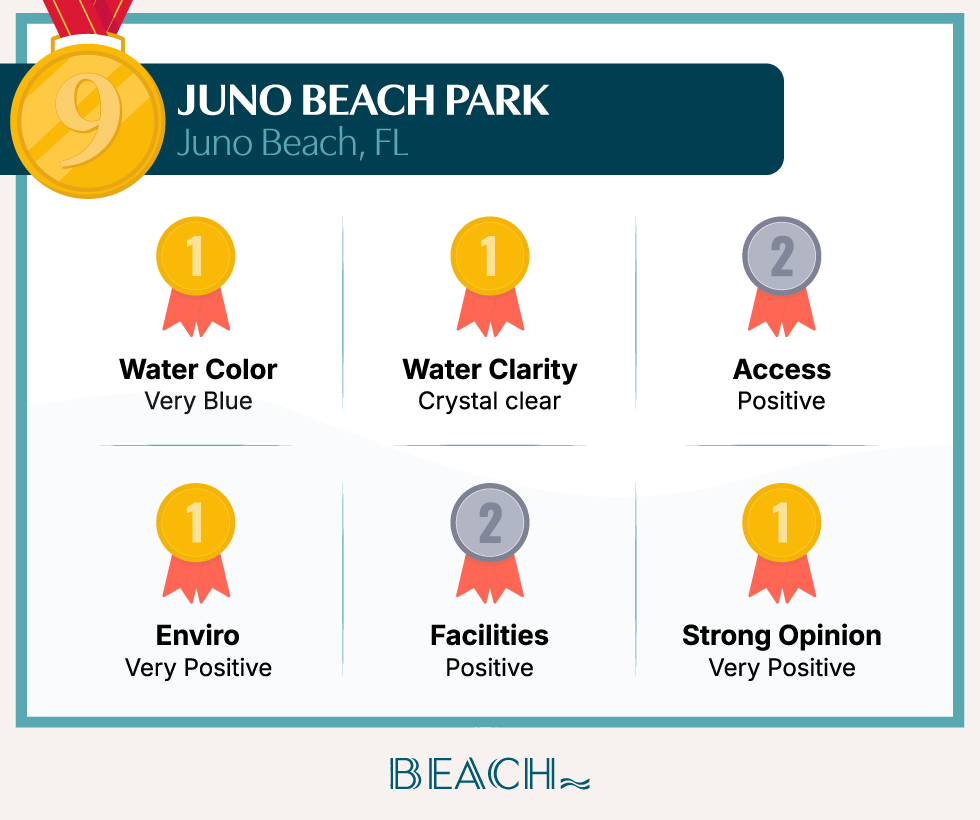
Rounding out our top 12, we end where we began in Palm Beach County, Florida. As you’ve likely noticed, the last four beaches in our analysis are all tied for ninth place. Juno Beach Park in Juno Beach, Florida, is a dog-friendly coastline with crystal-clear, very blue waters, a picnic area and a pier. It earns a very positive rating in the environmental cleanliness, overall experience and the strong, positive language categories.
Just a 30-minute drive from West Palm Beach airport, but far enough away from the West Palm Beach metro to escape most of the hustle and bustle of the city. Although there is plenty of parking, the beach doesn’t rank very high for beach access, with many citing the crowded conditions that can be found here. However, with over 3,000 reviews and a 4.8 average star rating on Google, few can find anything bad to say about Juno Beach Park.
More Info: discover.pbcgov.org; 14775 U.S. Hwy 1, Juno Beach, FL 33408
Behind the Rankings: Cleanest, Clearest, and Most Loved Beaches in the Southeast
Where to Find the Best Beaches
If you’re looking for the best beaches in the U.S. Southeast, the data points definitively towards Florida, specifically Palm Beach County. Every beach in the top 12 list above is located in the Sunshine State, and six are in Palm Beach County, including the top three best beaches — Ocean Reef Park, Riviera Beach, John D. MacArthur Beach State Park, and Carlin Park.
However, that is not to say that the other states in the Southeast don’t have standout postcard-perfect beaches. Our study analyzed over 1,300 beaches, with just over 350 making it into the final results. Of those, 267 were located in Florida, 46 in North Carolina, 35 in South Carolina, and 17 in Georgia.
For instance, Bonnett Street Public Beach Access in Nags Head, North Carolina, ranks #1 in the entire study for its accessibility and also #1 for the most-positive, strong opinions category. In other words, Bonnett Street Public Beach Access is a true crowd-pleaser, eliciting the strongest and most positive emotions from reviewers among all the beaches we examined.
The Great Dunes Pavilion in Jekyll Island, Georgia, ranks #1 in the facilities condition category. While facilities alone are no reason to visit a beach, you won’t find any in better shape across the whole southeastern U.S.
Water Color, Clarity, and Natural Beauty
When it comes to the cornerstone of this study, water color and clarity analysis via satellite data, not all beaches are created equal. According to our data, which examined five years of MODIS-Aqua satellite information, there are a total of 39 beaches in the Southeast that strike the perfect balance of very blue and crystal-clear water; it’s the ideal combination of low chlorophyll-a concentrations and high blue-band reflectance.
Amazingly, there is one beach in the southeast that takes #1 for both the bluest water and the clearest water. Delray Public Beach in (you guessed it) Palm Beach County, Florida, has the most optically pristine beach waters in the analysis, out of 1,300 beaches analyzed. This is what the perfect water of Delray Public Beach looks like:
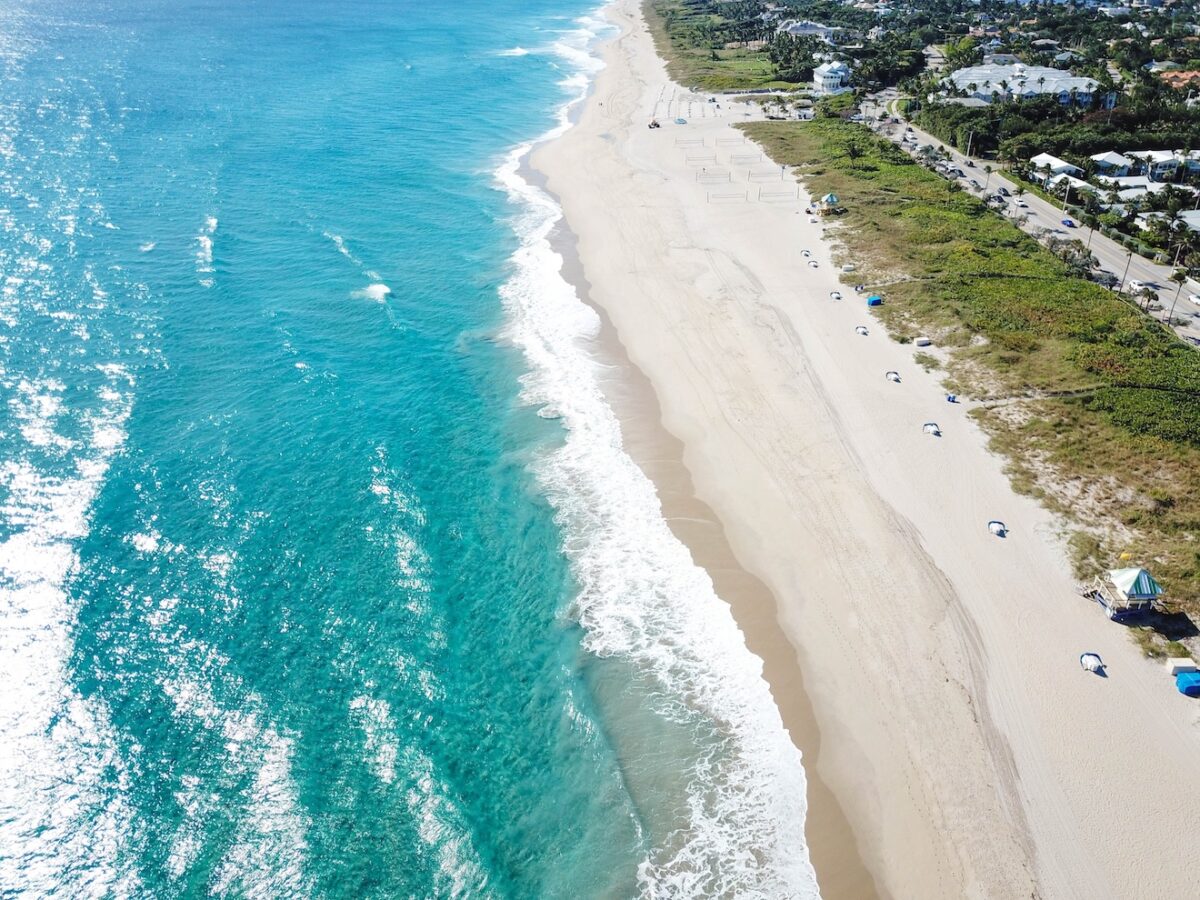
Separating water color from clarity, 148 beaches in our analysis have blue or very blue water color, while another 218 have slightly green, murky green, or deep green waters. On the clarity side, 127 beaches have clear, very clear, or crystal clear water. Funny enough, another 127 have fairly turbid or very turbid waters.
When we consider environmental conditions from a crowd perspective, Crescent Beach in St. Augustine Beach, Florida, takes the top spot. No other beach in the entire analysis is as highly praised for its clean and pristine environment. This is even despite the fact that Crescent Beach has slightly green and fairly turbid waters, proving that what is best is truly subjective.
Experience According to the Crowd
Satellite data tells one story, but what do real beachgoers say?
For starters, the most reviewed beach in our analysis is Siesta Beach in Siesta Key, Florida, with over 25,000 Google reviews. Despite the volume, it maintains a 4.8-star average rating on Google. Despite its typically slightly green and fairly clear waters, Siesta Beach is clearly a crowd favorite, thanks to its excellent beach facilities and the strong, positive emotions elicited from reviewers. We already have your vacation planned. Check out our dreamy three-day Siesta Key itinerary and pack your bags!
The beaches with the highest average star rating on Google are Frisco Beach in Hatteras, North Carolina, and Cumberland Island National Seashore in St. Marys, Georgia; each has a 4.9 average. However, it’s worth noting that both of these beaches have some of the fewest reviews in the analysis, and Frisco Beach, with only 153 reviews, is the least reviewed of the final 365 beaches.
Nevertheless, of the final 365 beaches, every single beach, save one, had positive or very positive average sentiments in our strong opinions category, which means that when reviewers choose to elicit strong emotions about a beach, they’re overwhelmingly positive strong emotions for 365 of these beaches.
Only 19 beaches received a very positive designation for easy, quick, and painless beach accessibility, making it one of the more challenging categories for beaches to rank well in. A whopping 133 beaches received a very positive designation for environmental cleanliness. Still, 95% of the beaches in our final analysis landed at least a positive designation in the access and environment categories.
The weakest categorical link is the provision of beach facilities. The most frequent criticism of beach conditions is the state of beach facilities. However, 86% of the final 365 beaches analyzed received at least a positive rating for facility cleanliness.
For something like the conditions of bathrooms and showers in a public area, an 86% positivity rate is pretty good. In fact, most of these beaches are idyllic. Negative sentiments were almost non-existent across all categories for all beaches. Only two beaches received a negative designation, and both were in the environmental cleanliness category.
Your Dream Beach Is Out There; We’ll Help You Find It
The Southeast has no shortage of spectacular beaches. Although Florida clearly delivers the clearest, bluest waters and best-reviewed shorelines, and dominates the results, you can hardly go wrong with the pristine beaches of Georgia, North Carolina, and South Carolina, too. Check out our more niche selection, such as the Best Beaches in North Carolina for Families, for example.
We are your go-to source for all your beach travel inspiration. From hidden gems to the best of the best, join us at Beach.com, where we will connect you with your ideal beach destination in the U.S. and beyond. So what are you waiting for? The shore is calling, let’s go!
Sources and Methodology
To identify and rank the best beaches in the U.S. Southeast, we compiled a comprehensive list of coastal beaches using OpenStreetMap data and a buffer-based coastal filter implemented via GeoPandas. We cross-referenced this list with EPA BEACON records, ultimately identifying 1,346 unique beaches across Florida, Georgia, South Carolina, and North Carolina.
We then collected Google Maps reviews for each beach, filtering by 340 custom keywords related to accessibility, environmental cleanliness, amenities, and public sentiment. This yielded 223,877 relevant review excerpts across 711 beaches. We applied natural language processing using the RoBERTa Base sentiment model to analyze sentiment at the sentence level, assessing how each keyword was discussed. Beaches with fewer than 10 qualifying reviews in any category were excluded, leaving 397 for scoring.
To assess water quality, we analyzed MODIS-Aqua satellite data via Google Earth Engine, focusing on chlorophyll-a, turbidity (Kd_490, estimated using a published model), and water color. We collected five years of summer-only data (2019–2023) and used direct sampling, offshore nudging, or buffered spatial averaging to extract values for 739 beaches.
For airport accessibility, we calculated straight-line distances from each beach to the nearest commercial airport using Haversine geometry.
Finally, we scored each beach using a weighted composite of nine metrics, including satellite-derived water data, public sentiment, and Google Maps ratings, to produce an overall ranking. Manual quality checks ensured only true beaches remained, resulting in 365 beaches included in the final analysis.
Click to Expand the Full Methodology
Source List: To obtain a list of every beach in the U.S. Southeast, we utilized Overpass Turbo to create a custom query that retrieved all geographic features tagged as natural beaches on OpenStreetMap (OSM) via the API for each state in the Southeastern U.S. by using coordinate bounding boxes. Then, to ensure our dataset only included coastal beaches, we created a buffer-based filter using geopandas by loading the Natural Earth Coastline and Country shapefiles and applying a 10 km buffer around the entire southeast coastline.
Second Source: We merged these buffered segments into a single geometry, forming a continuous coastal zone for spatial comparison, which allowed us to test each beach point for spatial inclusion. Our resulting list was of 365 coastal beaches across Florida, Georgia, South Carolina, and North Carolina. To ensure we captured every beach across these states, we then downloaded lists of beaches by state from the EPA BEACON system. We cross-referenced our two lists and deduplicated them to ensure accuracy and consistency. Afterward, 1,346 beaches remained.
Review Collection: Then, using our list of 1300+ beaches, we searched each one individually on Google Maps. For beaches with a direct match, we then gathered all Google Maps reviews that contain one of the 340 keywords on our list. Afterward, 776 beaches matched perfectly on Google Maps. Our list of 340 keywords was used to measure public opinion of these beaches surrounding four categories: Accessibility, environment, facilities, and general public opinion. Only 711 beaches remained that had any reviews that matched any of our 340 keywords.
NLP: Next, we conducted a large-scale natural language processing (NLP) analysis of the 223,877 Google Map reviews across the 711 remaining beaches. Using Python RE, we employed keyword-based extraction to extract the specific sentence in which each keyword is used within a review. Then, we ran the Roberta Base Sentiment model on each review sentence containing one of the keywords on our list. This allowed us to analyze the individual sentiment surrounding that keyword rather than the entire review. Many reviews contain more than one of our keywords, and reviewers can address multiple points in a single review. Keyword-based sentence extraction, performed before running a sentiment analysis, allowed us to identify the individual sentiments surrounding each keyword for categorical analysis.
Sentiment Categories: We organized sentiment metrics for each category using a pre-defined mapping table of 340 keywords across four categories. Sentiment values were then averaged per category for each review, plus an overall sentiment score for the entire review. The per-review sentiment values were then aggregated to the beach level using the mean sentiment score for each category, plus the overall mean score. We then eliminated any beaches from further analysis that did not have at least 10 reviews in any given keyword category. This resulted in 397 beaches left for further analysis.
Water Data: We analyzed water clarity, turbidity, and color data to identify the beaches with the clearest blue water. We used satellite-derived ocean color measurements from NASA’s MODIS-Aqua satellite mission. Using Google Earth Engine (GEE), we accessed Level-3 Standard Mapped Image (L3SMI) data for the following three remote sensing bands: chlorophyll-a concentration (chlor_a), remote sensing reflectance at 443 nm (Rrs_443), and 555 nm (Rrs_555). Data for each beach was extracted using point geometries corresponding to the latitude and longitude of each beach site. We focused our data collection on the summer months, specifically June, July, and August, over five years from 2019 to 2023. This ensured we only captured representative, seasonal water clarity and color, while the five-year span allows for quality control. For each beach coordinate pair, the mean value for each band was calculated over the five-year summer composite, with a spatial resolution of 4 km.
Limitations: We encountered a limitation from GEE that is widely acknowledged, which is the absence of the Derived light attenuation coefficient (Kd_490) data. This is one of the best indicators of water clarity. However, models exist to estimate this value. We used a published empirical model (Mueller 2000) to estimate the Derived light attenuation coefficient (Kd_490) by a ratio of the Rrs_443 and Rrs_555 bands (Kd₄₉₀ = 0.0166 + 0.15645 × (Rrs₄₄₃ / Rrs₅₅₅)^(–1.540)).
Other Limitations: Not all beaches returned values from GEE right away. To address this, we implemented a correction process to nudge the coordinate pairs for beaches that returned no data from GEE slightly offshore, ensuring that the coordinate points were located in the water next to the beach and not on land. For these beaches, we relocated sampling points 2.5 kilometers towards the ocean, with nudging directions dependent on the beach location (i.e., nudging east for east coast beaches and nudging southwest for west coast Florida beaches).
Workaround: There were still beaches where both direct sampling and offshore nudging failed to return usable MODIS Aqua data. Our last fallback method used buffered spatial averaging. Instead of point sampling, we expanded the sample area using a buffer zone of up to 24 km. Values were averaged across all MODIS Aqua observations within that radius for each of these beaches. Between direct sampling, offshore nudging, and buffered spatial averaging, we successfully captured water clarity, turbidity, and color data for 739 beaches from the original list of 1,346.
Airport Data: To quantify airport accessibility for each beach, we computed the geodesic distance in miles from the nearest regional commercial airport. We sourced the full global airport dataset from OurAirports. We applied the following filtering criteria: Inclusion restricted to airports categorized as “medium” or “large” with scheduled commercial service in Alabama, Florida, Georgia, North Carolina, and South Carolina. Then, using each beach’s coordinate points, we applied the Haversine formula (with a standard Earth radius of 3,958.8 miles) to identify the nearest airport and its computed Haversine distance.
Beach Definition: After our analysis was complete, we performed manual quality checks to ensure that all locations in our analysis met the definition of a beach: a strip of land covered with sand, pebbles, or small stones at the edge of a body of water, especially by the ocean, between high- and low-water marks. After this manual process, 365 beaches were worthy of inclusion in the final analysis and resulting article.
Composite Score: To construct a composite ranking of the best beaches in the U.S. Southeast, we employed a weighted scoring model that incorporated our nine distinct quantitative and sentiment-based metrics. All data was normalized and calculated with a weighted linear equation. The metrics and their weights are as follows:
- Google Rating and Review Count (10%): A combined metric with 60% weight to the average star rating on Google Maps and 40% to the number of reviews.
- Chlorophyll-a Concentration (15%): Assesses the amount of phytoplankton biomass in water. Lower values mean bluer water with less algae.
- Diffuse attenuation coefficient at 490 nm (Kd_490) (15%): Assesses how much blue-green light is absorbed or reflected. Indicates water transparency or turbidity (haziness). Higher values mean better clarity and lower turbidity.
- Airport Proximity (5%): The Haversine (as-the-crow-flies) distance to the closest airport.
- Accessibility (10%): Average sentiment from reviewers related to general beach access and ADA.
- Environmental Cleanliness (10%): Average sentiment from reviewers related to beach litter, upkeep, and overall cleanliness.
- Facilities (10%): Average sentiment from reviewers related to restrooms, showers, and structural beach amenities.
- Public Opinion (10%): Average general sentiment about a beach related to opinion-heavy language from reviewers.
- Overall Sentiment (15%): An aggregate sentiment depicting the overall feelings about a beach from all beach reviewers.
Fair Use
When using this data and research, please attribute by linking to this study and citing Beach.com.

